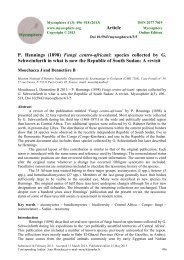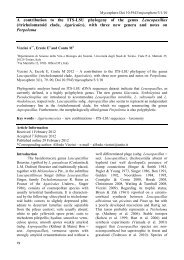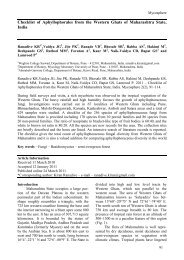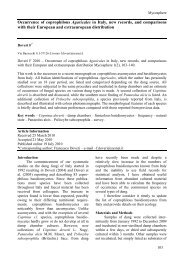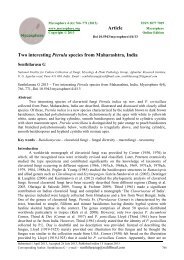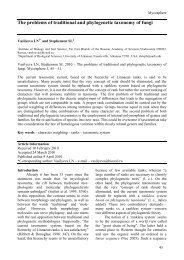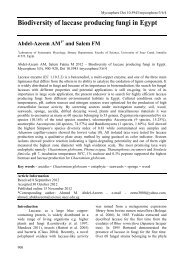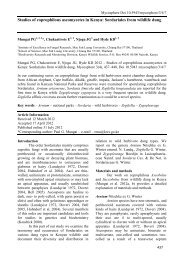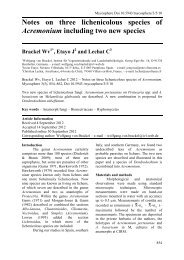Fungi Fimicoli Italici - Mycosphere-online journal
Fungi Fimicoli Italici - Mycosphere-online journal
Fungi Fimicoli Italici - Mycosphere-online journal
You also want an ePaper? Increase the reach of your titles
YUMPU automatically turns print PDFs into web optimized ePapers that Google loves.
The microscopic characteristics of species<br />
from damp chambers were studied on fresh<br />
material, those of species collected from the<br />
field were usually studied on dried material,<br />
using water, Congo red, Melzer's reagent, lactic<br />
cotton blue (or methyl blue), and Indian ink as<br />
mounting media.<br />
All Basidiomycetes and most Ascomycetes<br />
were preserved as dried material or,<br />
exceptionally, as slides in the author's personal<br />
herbarium (CLSM) or rarely in herbarium of<br />
Pisa Botanical Garden (PI). Chaetomium murorum,<br />
Cleistothelebolus nipigonensis, and Rodentomyces<br />
reticulatus were also preserved as<br />
living cultures (PI)<br />
Results<br />
In my monograph on coprophilous fungi<br />
from Italy (Doveri 2004a) I described 81 taxa<br />
332<br />
of Basidiomycota and 214 of Ascomycota<br />
growing both in the natural state or in damp<br />
chamber cultures. Since then my research has<br />
continued resulting in many publications<br />
(Doveri 2004b, 2005, 2006, 2007a,b, 2008a,b,c,<br />
2010a,b, Doveri et al. 2005, 2010a,b, Doveri &<br />
Coué 2008a) reporting 43 additional species (5<br />
Basidiomycota; 38 Ascomycota) new to Italy,<br />
13 of which are described in this work, and one<br />
genus (Rodentomyces Doveri et al.), four<br />
species (Podospora alexandri Doveri, Sporormiella<br />
hololasia Doveri, Thecotheus neoapiculatus<br />
Doveri & Coué, Coprinellus mitrinodulisporus<br />
Doveri & Sarrocco), one variety<br />
(Tripterosporella heterospora var. octaspora<br />
Doveri) and one form (Thecotheus formosanus<br />
f. collariatus Doveri & Coué) new to science<br />
(Table 1).<br />
badger (Meles meles) goose (Anser sp.) porcupine (Hystrix cristata)<br />
beech marten (Martes faina) hare (Lepus sp.) rabbit (Oryctolagus cuniculus)<br />
bird (various, except for Anser sp.) hedgehog (Erinaceus europaeus) rat (Rattus rattus)<br />
cattle (Bos taurus) horse (Equus caballus) rock goat (Capra ibex ibex)<br />
chamois (Rupicapra rupicapra) insect (various) roe deer (Capreolus capreolus)<br />
deer (Cervus elaphus) lizard (Lacerta sp.) sheep (Ovis aries)<br />
dog (Canis familiaris) marmot (Marmota marmota) snail (Helix sp.)<br />
donkey (Equus asinus) marten (Martes martes) squirrel (Sciurus sp.)<br />
dormouse (Glis glis) mouflon (Ovis musimon) toad (Bufo sp.)<br />
fallow deer (Dama dama) mouse (Mus musculus) tortoise (Testudo sp.)<br />
ferret (Mustela furo) mule (Equus mulus) weasel (Putorius nivalis)<br />
fox (Vulpes vulpes) ostrich (Struthio camelus) wild pig (Sus scrofa)<br />
gecko (Tarentola mauritanica) pig (Sus scrofa domesticus) wolf (Canis lupus)<br />
goat (Capra hircus) polecat (Putorius foetidus)<br />
I have recorded, at present, 544 collections<br />
of 92 Basidiomycota species from 722<br />
dung samples in Italy.<br />
303 records of 88 species came from 303<br />
samples detected and identified in the field,<br />
listed as substrate sources, but not cultured. All<br />
but two (Sebacina epigaea; Sphaerobolus<br />
stellatus) are Agaricales, whose occurrence in<br />
Italy has recently been reported (Doveri 2010<br />
b). The overall picture is unchanged, so I limit<br />
myself to summarise the results (Tables 2–3)<br />
and refer to that work for details.<br />
I have recorded, at present, 2312 collections<br />
of 256 Ascomycota species from Italy.<br />
573 records of 156 species came from samples<br />
detected and identified in the field. Leaving out<br />
29 records from unidentified animals, most<br />
findings (96%) were made on bovine (27%),<br />
cervine (23%), equine (18%), leporine (13%),<br />
ovine (12%), and caprine (3%) dung, the<br />
remaining 4% on dung of other animals, with a<br />
slight preponderance of pyrenomycetes s.l.<br />
(53%) on discomycetes (45%), and with a<br />
marked preponderance of Sporormiella (19%),<br />
followed by Ascobolus Pers. (8%), Lasiobolus<br />
Sacc. (8%), Sordaria Ces. & De Not. (8%),<br />
Cheilymenia Boud. (7%), Podospora Ces.,<br />
(7%), and Schizothecium Corda (7%). The<br />
preference for bovine dung is marked (72%) in<br />
Cheilymenia, slighter in Ascobolus (29%) and<br />
Schizothecium (20%), while a preference for<br />
cervine dung is manifest in Lasiobolus (38%),<br />
Sporormiella (30%) and Podospora (29%), for<br />
leporine dung (36%) in Sordaria.<br />
Another 432 dung samples of 42 animal<br />
species were cultured in damp chambers and



